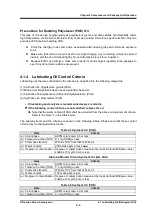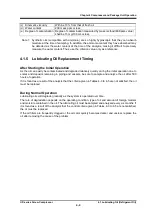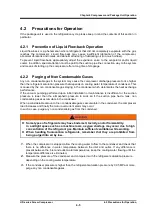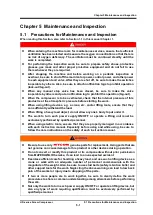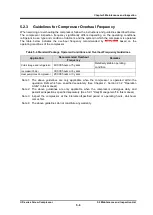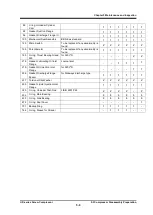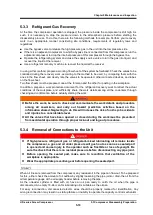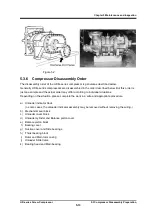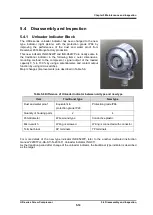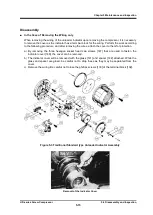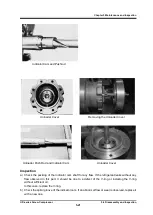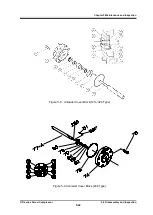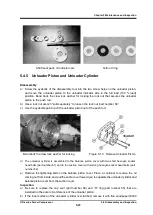
Chapter 5 Maintenance and Inspection
UD-series Screw Compressor
5.3 Compressor Disassembly Preparation
5-10
5.3.3 Refrigerant Gas Recovery
At the time the compressor operation is stopped, the pressure inside the compressor is still high. As
such, it is necessary to drop the pressure down to the atmospheric pressure before starting the
disassembly process. To do this, there are the following methods for example. Perform your recovery
work in an appropriate manner considering site conditions, requirements of regulatory laws and
regulations.
■
Use the bypass valve to release the high pressure gas in the unit into the low pressure side.
■
If there is an adjacent compressor to which a bypass line is connected from this compressor, run the
adjacent compressor to drop the internal pressure of this compressor through the bypass line.
■
Operate the refrigerating system and close the supply source valve to turn the gas into liquid, and
recover the liquid at the receiver.
■
Use a refrigerant recovery machine to recover the liquid at the receiver.
In using either method, prepare a working flow sheet of the system beforehand. Check the valves to be
controlled during the recovery work, according to the method to be used, by comparing them with the
ones in the flow sheet, and clearly note the valves to be operated, other connected devices, and tubes
on the flow sheet.
Two flow sheets must be prepared: one at the foreman and the other for posting in the workplace.
In addition, prepare a work procedure document for the refrigerant recovery work to reflect the actual
conditions of the workplace, and sufficiently share the work details among all the coworkers through
checking and confirmation before actually starting the work.
Before the work, be sure to check and communicate the work details and procedure
among all coworkers, and carry out hazard prediction activities based on the
information shared. Neglecting to do this will increase the risk of on-the-job accidents
and injuries to a considerable level.
All the valves that have been opened or closed during the work must be prevented
from accidental operation through proper lock-out and tag-out procedures.
5.3.4 Removal of Connections to the Unit
If high-pressure refrigerant gas or refrigerant-mixed lubricating oil remains inside
the compressor, a gas and oil under pressure will gush out as soon as a sealed part
is opened and cause injury to the operator such as frostbite or loss of eyesight. Be
sure the check that there is no residual pressure before disconnecting any pipe joint.
Before opening the sealed part, make sure to reconfirm that ventilation of the
workplace is appropriate.
Wear the appropriate preventive gear before opening the sealed part.
When oil lines are removed from the compressor, any residual oil in the pipe can flow out. To be prepared
for this, either check the amount of oil outflow by slightly loosening the pipe joint or drain the oil from the
oil temperature gauge at the oil supply header before removing the pipe.
As the unloader cylinder is filled with oil, have an oil pan ready to catch the oil when the pipe is
disconnected. An empty 18-liter can for lubricating oil is suitable as the oil pan.
For easy reconnection, disconnected electric wires should be properly marked for identification. Any
wrong reconnection may result in a startup failure or inability to operate the capacity control mechanism.


